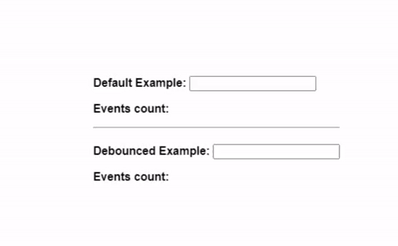Table of Contents
Open Table of Contents
Debounce

First, let’s go over a use-case scenario to get a better understanding of Debounce. Imagine a case where you have to optimize a search bar. As someone types into a search bar, the client makes a request and fetches some data, let’s suppose these are list of books, but here is the catch: As user keeps typing, our search function instantly makes a request and fetches, by the way, this is not a wrong way of doing things but makes too much burden for our backend services. Because, now, our services have to fetch all-time until the user finishes typing this is costly both for the client and server.
Example
const debounce = (func, wait, immediate, args) => {
let timeout;
return () => {
const callNow = immediate && !timeout;
if (callNow) func.apply(null, args);
const later = () => {
timeout = undefined;
if (!immediate) func.apply(null, args);
};
clearTimeout(timeout);
timeout = setTimeout(later, wait);
};
};
const myEfficientFn = debounce(function () {
console.log("Costly calculations.");
}, 1000);
window.addEventListener("resize", myEfficientFn);In this example we are trying to debounce the resizing of the window. Our debounce function accepts few params such as a func which is a
function we are going to call after desired time passes, wait, immediate to not wait for debounced function, we pass true, and args to pass some extra arguments
to pass onto our inner function.
Then we need to define timeout for our closure. We should be able to access timeout
only from our inner functions and should pass itself to other function calls. Consider this example below.
Closure
const add = () => {
let total = 0;
return (a, b) => {
console.log("Total value", total);
total += a + b;
return total;
};
};
const letsAdd = add();
console.log(letsAdd(1, 2)); // Returns 3
console.log(letsAdd(4, 5)); // Returns 12If it was a regular function, first would’ve returned 3 and second one would’ve returned 9, but second one returned 12 because we are adding to total
which keeps getting stored between function calls thanks to closures and lexical scopes.
So that why we’ve defined timeout. To not lose track of it. Then, inside our inner function we first check if user passed immediate if it’s true, then we check
if our timeout has a value, then we call our function right away with func.apply.
Function.Apply()
Math.max(1, 2, 3, 4); // Will return 3
Math.max.apply(null, [1, 2, 3, 4]); // Will also return 3If I have to explain func.apply() briefly: Since Javascript arrays do not have a method called max().
In order to find a maximum value we either have to iterate over array or use apply. First argument is not really important if it’s applied on functions,
but it’s used when applied on Objects. Another example would be:
const array = ["a", "b"];
const elements = [0, 1, 2];
array.push.apply(array, elements);
console.info(array); // ["a", "b", 0, 1, 2]If you have to do it with array push, you would first iterate it over then push elements one-by-one. So, we use apply when we want o avoid iteration. And, also, we used
first argument. Because, we need a context to apply on. We pushed elements array to array. Okay, let’s continue where we left off.
So, if it’s immediate not passed in, we move onto our setTimeout(). Quick setTimeout() reminder.
setTimeout()
setTimeout(() => console.log("Hello World!"), 2000);It will print out Hello World! after 2000 milliseconds passed. When usually people want to delay things setTimeout() is used.
Before we call setTimeout() we first call clearTimeout(). Reason is, if user resizes the window before the function
completes, and, then another debounce method gonna fire. So, to avoid such cases we use clearTimeout() to ensure there are no unfinished calls. Finally, we just wait setTimeout()
complete and call our later() function so we can invoke passed func.
Debounce use cases:
- Don’t make any axios requests until user stops typing.
- Don’t do anything while user drags and drops.
- Wait until the user stops resizing the window.
Throttle

Throttle and debounce shares some similarities, but the throttle is another beast. Unlike debounce, throttle only allows a certain amount of actions within a given time. Such as the example above. But, debounce waits until the process to be completed first, and only then proceeds to do the costly calculation.
Example
const throttle = (func, duration) => {
let shouldWait = false;
return (...args) => {
if (!shouldWait) {
func.apply(null, args);
shouldWait = true;
setTimeout(function () {
shouldWait = false;
}, duration);
}
};
};This function looks similar to debounce, but now we are storing a boolean variable across function calls to ensure that our function cannot be called if it’s already called.
Then, after we applied that function we toggle shouldWait to true. After a certain amount of time has passed, referencing duration here, then we toggle our shouldWait to false
to make our throttle function callable.
Throttle use cases:
- Disable button click so users cannot spam.
- Throttling after mousemove.
- Throttling API calls.